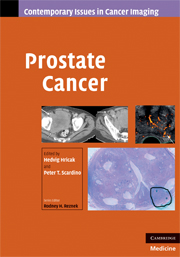Book contents
- Frontmatter
- Contents
- Contributors
- Series Foreword
- Preface
- 1 Anatomy of the prostate gland and surgical pathology of prostate cancer
- 2 The natural and treated history of prostate cancer
- 3 Current clinical issues in prostate cancer that can be addressed by imaging
- 4 Surgical treatment of prostate cancer
- 5 Radiation therapy
- 6 Systemic therapy
- 7 Transrectal ultrasound imaging of the prostate
- 8 Computed tomography imaging in patients with prostate cancer
- 9 Magnetic resonance imaging of prostate cancer
- 10 Magnetic resonance spectroscopic imaging and other emerging magnetic resonance techniques in prostate cancer
- 11 Nuclear medicine: diagnostic evaluation of metastatic disease
- 12 Imaging recurrent prostate cancer
- Index
- Plate section
- References
12 - Imaging recurrent prostate cancer
Published online by Cambridge University Press: 23 December 2009
- Frontmatter
- Contents
- Contributors
- Series Foreword
- Preface
- 1 Anatomy of the prostate gland and surgical pathology of prostate cancer
- 2 The natural and treated history of prostate cancer
- 3 Current clinical issues in prostate cancer that can be addressed by imaging
- 4 Surgical treatment of prostate cancer
- 5 Radiation therapy
- 6 Systemic therapy
- 7 Transrectal ultrasound imaging of the prostate
- 8 Computed tomography imaging in patients with prostate cancer
- 9 Magnetic resonance imaging of prostate cancer
- 10 Magnetic resonance spectroscopic imaging and other emerging magnetic resonance techniques in prostate cancer
- 11 Nuclear medicine: diagnostic evaluation of metastatic disease
- 12 Imaging recurrent prostate cancer
- Index
- Plate section
- References
Summary
Introduction
In the setting of recurrent prostate cancer (PCa), awareness and understanding of clinical findings are essential for accurate imaging interpretation. Accordingly, this text will first address the principles of recurrent PCa management. Subsequently, the principles of recurrent PCa evaluation with computed tomography (CT), magnetic resonance imaging (MRI), transrectal ultrasound (TRUS), and TRUS-guided biopsy will be described. Nuclear medicine methods are reviewed in Chapter 11.
Management principles of recurrent prostate cancer
General principles
Prostate cancer is usually suspected based on the detection of an abnormal serum prostate-specific antigen (PSA) value (≥4 ng/ml is the most commonly used criterion) and diagnosed by TRUS-guided systematic prostate biopsy [1]. With systematic biopsy, one or more cores are obtained from each prostate sextant regardless of TRUS findings [2]. Although optional additional cores can be obtained from regions that are abnormal on TRUS or other imaging modalities, image-guided biopsy is currently accepted only as an adjunct to systematic biopsy [2]. Biopsy results are used to assign the Gleason grade [3]. Digital rectal examination (DRE) findings are used to determine clinical tumor stage; however, due to earlier detection by PSA testing, PCa is now non-palpable in about two-thirds of patients and the clinical stage often underestimates the pathologic tumor stage [4, 5] (Table 12.1).
Newly diagnosed PCa is designated as “primary” PCa and its treatment modalities are designated as “primary” treatments.
- Type
- Chapter
- Information
- Prostate Cancer , pp. 195 - 222Publisher: Cambridge University PressPrint publication year: 2008
References
- 1
- Cited by



